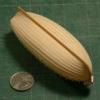-
Posts
13,303 -
Joined
-
Last visited
Content Type
Profiles
Forums
Gallery
Events
Everything posted by druxey
-
Congratulations on reaching the milestone at the end of Volume I, Remco. Well done indeed!
- 1,215 replies
-
- sloop
- kingfisher
-
(and 1 more)
Tagged with:
-
The model makers there look like zombies: they've been at it far too long!
- 241 replies
-
- royal caroline
- yacht
-
(and 1 more)
Tagged with:
-
Did I ever mention palliasses? Did I? Well, you beat me to it, Remco. Now, about those fleas.... Joking aside, that is beautifully done. Congratulations!
- 1,215 replies
-
- sloop
- kingfisher
-
(and 1 more)
Tagged with:
-

ROYAL CAROLINE 1749 by Doris - 1:40 - CARD
druxey replied to DORIS's topic in - Build logs for subjects built 1501 - 1750
Um... Nelson wasn't even born until 1758. Beautiful work as usual, Doris!- 883 replies
-
- royal caroline
- ship of the line
-
(and 1 more)
Tagged with:
-

making sweeps
druxey replied to hamilton's topic in Discussion for a Ship's Deck Furniture, Guns, boats and other Fittings
Your query about the ends of the sweep blades: these were bound in thin metal strapping for protection. The metal may or may not have been painted. -
Looks delightful. You are a master in metal, Michael!
- 2,215 replies
-
Ye gads! Lovely detail, Michael. Just as well she's not a three masted square rigger. You'd be building blocks forever!
- 2,215 replies
-
Nice, Toni. Time to sling a hammock or two!
- 1,449 replies
-
Beautifully done! Your solution to the difficulty of carving thin pieces is one way of getting around it. I white glue thin pieces on to a backing board to carve them, then dissolve the glue with isopropanol when finished. Then, if the back of the carving needs work, I use fine files or sanding sticks to lessen the chance of breaking a piece off. As another person mentioned, boxwood is a better choice of wood.
-

Hatch covers.
druxey replied to mikeaidanh's topic in Discussion for a Ship's Deck Furniture, Guns, boats and other Fittings
Stay tackle, as shown in the illustration, are rigged conveniently above the fore and main hatches. Zeh has it right. -
Sweet! Having recently learned repoussé techniques, I recognize some of the tools you've used to form the metal.
- 2,215 replies
-

ROYAL CAROLINE 1749 by Doris - 1:40 - CARD
druxey replied to DORIS's topic in - Build logs for subjects built 1501 - 1750
I imagine that the gun crew would not be just standing there during firing, but covering their ears with their hands!- 883 replies
-
- royal caroline
- ship of the line
-
(and 1 more)
Tagged with:
-
Hah! You were doomed, Michael…. I had a similar experience. Some years ago, my mother was down-sizing and came across a construction paper booklet. It was a 'diary' that I had made in school when I was about six years old. On opening this, the first entry read, in a very childish hand, "I am building a ship model". Also doomed.
- 2,215 replies
-

ancre LE BONHOMME RICHARD by Jeronimo - FINISHED
druxey replied to Jeronimo's topic in - Build logs for subjects built 1751 - 1800
Enjoy your new toy, Karl! Thanks for clarifying that you were using imitation gold, rather than real gold leaf. I guess that's why you could afford the lathe!- 662 replies
-
- bonhomme richard
- frigate
-
(and 1 more)
Tagged with:
-
This continues to be a fascinating build. Lovely work, Ed!
- 3,618 replies
-
- young america
- clipper
-
(and 1 more)
Tagged with:
About us
Modelshipworld - Advancing Ship Modeling through Research
SSL Secured
Your security is important for us so this Website is SSL-Secured
NRG Mailing Address
Nautical Research Guild
237 South Lincoln Street
Westmont IL, 60559-1917
Model Ship World ® and the MSW logo are Registered Trademarks, and belong to the Nautical Research Guild (United States Patent and Trademark Office: No. 6,929,264 & No. 6,929,274, registered Dec. 20, 2022)
Helpful Links
About the NRG
If you enjoy building ship models that are historically accurate as well as beautiful, then The Nautical Research Guild (NRG) is just right for you.
The Guild is a non-profit educational organization whose mission is to “Advance Ship Modeling Through Research”. We provide support to our members in their efforts to raise the quality of their model ships.
The Nautical Research Guild has published our world-renowned quarterly magazine, The Nautical Research Journal, since 1955. The pages of the Journal are full of articles by accomplished ship modelers who show you how they create those exquisite details on their models, and by maritime historians who show you the correct details to build. The Journal is available in both print and digital editions. Go to the NRG web site (www.thenrg.org) to download a complimentary digital copy of the Journal. The NRG also publishes plan sets, books and compilations of back issues of the Journal and the former Ships in Scale and Model Ship Builder magazines.


